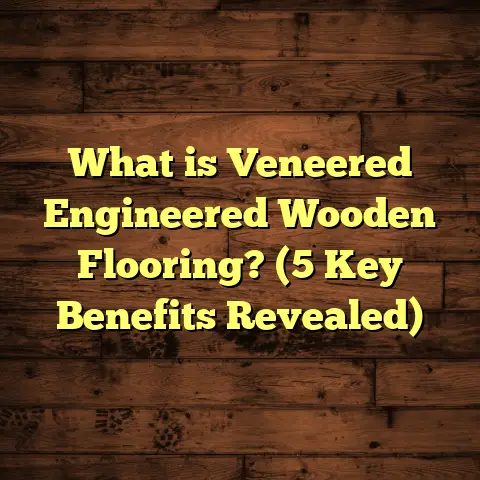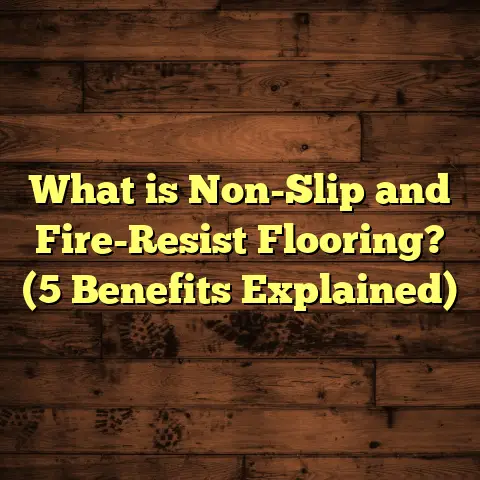What is a Floor Base? (5 Essential Facts for Home Builders)
Expert Picks on Floor Bases: Why They Matter
I’ve been in the flooring business for a good while now, and one thing I’ve noticed is how the floor base often flies under the radar. When people pick out their flooring materials—hardwood, tile, carpet—they usually focus on color, texture, and style. But the floor base? It’s like the unsung hero of the whole project.
Why do experts keep hammering on about it? Because a great floor base lays down the groundwork (literally) for a strong, smooth, and long-lasting floor. Without it, even the most expensive flooring can end up damaged or uncomfortable.
I’ve been involved in dozens of projects where attention to the floor base made all the difference between a floor that lasted decades and one that started creaking or cracking in no time. Some of these projects involved straightforward repairs; others were brand-new builds where we had to decide what kind of base would work best.
So, I want to share what I’ve learned—from hands-on experience and research—and give you some solid facts that home builders and DIYers can really use.
What Is a Floor Base?
Let’s start at square one: what is a floor base?
The floor base is essentially the foundation layer beneath your finished flooring. It’s what supports the entire floor covering, whether that’s hardwood planks, tiles, carpet, or vinyl sheets. Think of it as the “soil” or “concrete slab” that holds everything steady.
It’s not just one thing—floor bases differ depending on your home’s construction and the flooring type you want. Sometimes it’s a thick concrete slab poured directly on the ground in basements or slabs-on-grade homes. Other times, it’s layers of plywood or oriented strand board (OSB) nailed down to wooden joists in wood-frame houses.
A proper floor base does several things:
- Support: It carries all the weight from foot traffic, furniture, appliances, and more.
- Stability: It prevents movement like flexing or bowing that can damage floors.
- Moisture Control: It acts as a barrier or buffer against dampness coming from below.
- Sound Insulation: Some bases help reduce noise between floors.
- Level Surface: It provides an even plane to lay flooring on.
If any of these functions are compromised, you’ll likely see problems like sagging floors, squeaks, cracked tiles, or warped hardwood planks.
More Than Just a Layer
Here’s something I didn’t fully appreciate until a few years ago: A floor base isn’t just a physical layer—it’s part of the overall building system. It interacts with your home’s foundation, framing, insulation, and even HVAC systems.
For example, moisture levels in the soil beneath your foundation can affect concrete slab moisture content. This moisture then can move up into your flooring if there isn’t a proper vapor barrier in place at the base.
I once worked on a home where hardwood floors kept cupping and buckling shortly after installation. After careful inspection, we found excessive moisture traveling through an unsealed concrete slab. We had to install a vapor barrier and add extra ventilation to fix the problem. That was an expensive lesson in how interconnected these systems are.
5 Essential Facts About Floor Bases for Home Builders
1. The Floor Base Affects Stability and Longevity
One of my first projects involved installing hardwood floors over an old plywood subfloor that was clearly worn out. The subfloor was thin and not well fastened to joists. A few months after installation, boards started creaking and some even lifted slightly.
I learned then how critical a stable base is. You want your subfloor rigid enough to prevent bending but also secure enough not to shift under pressure.
Data Point: According to the National Wood Flooring Association (NWFA), floors installed on properly fastened subfloors have 70% fewer squeaks and structural issues during their lifetime.
The thickness and quality of the subfloor matter too. For example:
- Plywood: Should be at least 3/4 inch thick on joists spaced 16 inches apart.
- OSB: Usually okay as a budget alternative but less durable.
- Concrete slabs: Provide excellent support but need careful moisture control.
If you’re working with an older home, it pays to inspect the floor base carefully before installing new flooring. Sometimes replacing or reinforcing the subfloor saves you from bigger headaches later.
2. Moisture Control Starts at the Base
This is one thing I always emphasize: moisture control begins with your floor base.
Concrete slabs are notorious for moisture issues because they sit directly on or near soil. Without vapor barriers or sealants, water vapor can seep upward and cause mold, mildew, or warping in wood or laminate floors.
In one basement remodel I worked on, we used specialized vapor barriers beneath tile and vinyl plank flooring. We also applied sealants to concrete slabs to reduce moisture vapor emission rates (MVERs). The homeowner avoided expensive damage down the road thanks to that step.
Statistics: Flooring industry reports indicate that moisture-related damage accounts for about 25% of all flooring failures within two years of installation.
Wood subfloors aren’t immune either. In humid climates or near plumbing fixtures, untreated wood can absorb moisture leading to rot or mold growth. Applying moisture-resistant underlayment or sealants is often necessary.
If you’re unsure about moisture levels in your home’s subfloor or slab, consider investing in a professional moisture test before proceeding with installation.
3. Sound Insulation Depends on the Floor Base
Noise is something many people overlook until after moving into their homes. If you live in a multi-story house or apartment building, sound travels easily through floors without proper insulation.
I once had a client who complained about loud footsteps echoing through their upstairs rooms. We fixed it by adding cork underlayment beneath their hardwood floors over plywood subfloors. Cork is excellent at absorbing impact noise and also adds some thermal insulation.
Research shows adding soundproofing layers can reduce noise transfer by up to 50%. Some popular soundproofing materials include:
- Cork underlayment
- Rubber mats
- Foam mats designed for flooring
- Specialized resilient channels beneath subfloors
If noise is a priority for you or your clients, don’t underestimate the impact the right floor base can have on living comfort.
4. The Right Base Can Save You Money
Budgeting for flooring isn’t just about picking fancy materials; it starts with knowing exactly what kind of floor base you’ll need—and how much it will cost.
I use FloorTally pretty regularly for this reason. It helps me estimate material quantities and labor costs based on local pricing plus waste factors. For example, if I’m installing vinyl planks over an uneven concrete slab, FloorTally helps me figure out how much leveling compound I’ll need and what that means in terms of cost.
Having those numbers upfront means I can set realistic budgets with homeowners and avoid surprises mid-project.
Spending more upfront on a quality floor base—whether that means adding a moisture barrier or reinforcing joists—can save money long-term by preventing repairs or premature flooring replacement.
5. Different Flooring Types Need Different Bases
One mistake I see people make is assuming all floors can go down over any base material. Not true!
Each flooring type has specific requirements for its base:
- Hardwood floors need flat, solid subfloors like thick plywood or concrete slabs.
- Tile requires cement backer boards or concrete to prevent cracking.
- Carpet works best over plywood with padding underneath.
- Vinyl plank can sometimes go directly over existing floors but prefers smooth bases.
- Laminate usually needs moisture-resistant underlayment with sound absorption qualities.
For instance, putting tile over a flexible wooden subfloor without backer board almost guarantees cracked grout and tiles later on.
When planning flooring installation, always check manufacturer recommendations for subfloor conditions. That’s saved me from costly mistakes more than once.
My Personal Experience With Floor Bases
I want to share a couple stories that really drove home how important the floor base is.
Project One: The Warped Hardwood Nightmare
Years ago, I worked on a high-end custom home where the builder rushed through subfloor prep. The plywood was thin and uneven in spots with gaps between sheets—not ideal conditions for hardwood installation.
The hardwood looked great initially but started warping and buckling within six months. We had to pull up large sections and redo the subfloor entirely—a costly and frustrating fix for everyone involved.
Lesson learned: Never skimp on inspecting and prepping your floor base properly!
Project Two: Basement Moisture Mayhem
Another time I was called to fix a basement flooded with moisture that ruined newly installed laminate flooring. The problem? No vapor barrier beneath the concrete slab and poor drainage outside the foundation allowed water infiltration.
We installed a polyethylene vapor barrier underneath new vinyl plank flooring after sealing cracks in the slab and improving exterior drainage. The homeowner has had no issues since then.
These experiences have shaped how I approach every project now—with extra emphasis on getting the base right first.
Common Floor Base Materials & Their Uses
Let me break down some common floor base materials I see regularly:
| Material | Best For | Pros | Cons |
|---|---|---|---|
| Concrete Slab | Basements, ground-level floors | Strong, durable | Cold; needs vapor barrier |
| Plywood Subfloor | Wood-frame homes | Flexible; easy to install | Vulnerable to moisture if untreated |
| Cement Backer Board | Tile installations | Water-resistant; very stable | Adds weight; requires skill |
| OSB (Oriented Strand Board) | Budget plywood alternative | Affordable | Less durable than plywood |
| Foam/Cork Underlayment | Soundproofing under hardwood/laminate | Absorbs sound; adds comfort | Can compress over time |
Choosing between these depends on your home’s structure and flooring choice.
How I Use Data and Research in Flooring Projects
I mix hands-on experience with research to make smart decisions:
- NWFA studies show proper fastening reduces squeaks by 70%.
- Flooring manufacturers’ data reveals vapor barriers cut water damage warranty claims in half.
- Case studies demonstrate soundproofing layers improve resale value by making homes quieter and more comfortable.
Pairing this info with tools like FloorTally lets me build accurate budgets based on local labor/material costs plus waste factors—avoiding surprises for clients.
More Things You Should Know About Floor Bases
Subfloor Thickness Matters
Did you know that subfloor thickness affects your finished floor’s performance dramatically? Thin subfloors flex more under load which can lead to cracks or squeaks later on.
For example:
- For hardwood floors supported by joists spaced 16 inches apart, 3/4 inch tongue-and-groove plywood is ideal.
- For tile installations over wood framing, you might need thicker subfloors combined with cement backer boards for stability.
Fastening Techniques Are Crucial
How you attach your floor base matters as much as what you use:
- Nails alone often loosen over time.
- Screws provide better holding power but take longer.
- Using adhesive along with mechanical fastening can reduce movement further.
I always recommend using ring-shank nails or screws with glue where possible for subfloors supporting hardwood or tile.
Leveling Your Floor Base Can Make Installation Easier
Uneven bases are one of my biggest pet peeves because they complicate everything else:
- Tiles won’t lay flat without cracking grout.
- Hardwood planks may separate at joints.
- Vinyl sheets show bumps clearly.
Using leveling compounds or grinding concrete slabs smooth before installation makes life easier and improves final results significantly.
How FloorTally Helps Me With Floor Base Budgeting
I’m often asked how I come up with accurate cost estimates when planning flooring projects. Over time, I’ve found FloorTally incredibly helpful—not just for materials but also tasks related to preparing the floor base.
For example:
- When calculating costs for installing hardwood over plywood subfloors, I input local labor rates along with estimated plywood prices.
- For basement projects involving concrete slabs needing leveling or vapor barriers, I add those materials into FloorTally’s calculator.
- The tool factors in waste percentages so I order enough materials without excess leftover.
Using it saves me time hunting down separate quotes for materials vs labor vs prep work—and helps keep clients informed about where their money goes every step of the way.
Final Thoughts on Floor Bases: Why You Should Care
After all this talk about layers beneath layers… why should you care about your floor base?
Because it directly impacts:
- How long your floors last
- How comfortable your home feels
- Whether you avoid costly repairs
- Your home’s overall value
It might seem like just “underneath stuff,” but getting this part right pays dividends in peace of mind and durability. Whether you’re building new or remodeling existing floors, invest time inspecting and improving your floor base first.
Got questions about what kind of floor base fits your project? Or curious about how I estimate costs using tools like FloorTally? Just ask—I’m here to help!





